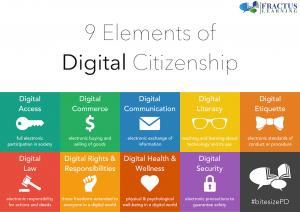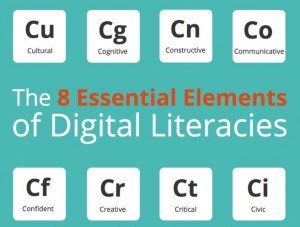NOTE: This post can also be read here at the book’s wiki, although that may be an edited version. Reflections from my classmates can be found at Nousion Readings.
The following are my Rich Reflections of Doug Belshaw’s book, The Essential Elements of Digital Literacies for ED F654.
We weren’t asked to reflect on the preface, but I was intrigued with the Open Beta self-publishing method Belshaw described. The concept of purchasing an almost blank book and reading it as it develops is a new one to me. It presents an opportunity to know the author in a different way.
Contents
Chapter 1 – Introduction
The author, Doug Belshaw, introduces not only what is to be found in each chapter but begins with a caution: “I’m going to begin with a bit of a warning.” Who would not want to continue reading with that beginning sentence? Most educationese that I read does not begin with an arresting sentence nor does it give the reader the immediate reassurance that the document will be readable without a dictionary constantly at your side.
Belshaw states that, “Whatever you’re looking to do, my aim is for this book to leave you asking the right questions.” I immediately wonder whether I’ll figure out what those are.
He says Chapter 3 is an odd beast. Will I be able to decipher his points or get lost in his discussion of ambiguity?
 After going through so many sources for our Dig Cit assignment, I’m interested to see what his eight elements of digital literacies will be. Mike Ribble of digitalcitizenship.net as well as other sites had defined nine elements of digital citizenship, of which digital literacy is one. I have included an eye-catching graphic from Fractus Learning. No wonder our course topic is so huge–each element is comprised of so many more!
After going through so many sources for our Dig Cit assignment, I’m interested to see what his eight elements of digital literacies will be. Mike Ribble of digitalcitizenship.net as well as other sites had defined nine elements of digital citizenship, of which digital literacy is one. I have included an eye-catching graphic from Fractus Learning. No wonder our course topic is so huge–each element is comprised of so many more!
I am interested to see that chapter 2 will posits that we don’t really understand traditional literacy. In an earlier blog post of mine, I approached the problem of defining ‘digital literacy’ as first figuring out what ‘literacy’ means. Perhaps I had a flash of being on the right track.
Chapter 2 – What’s the problem?
Belshaw begins with the problem of trying to define digital literacy. This leads him to explore the word ‘literacy.’ However, when he says “it is fair to consider ‘literacy’ as a kind of conceptual shorthand, “ I have no idea what he is saying. Then I tried to break down what ‘conceptual’ and what ‘shorthand’ each mean and am still stuck. I can concur with his idea that literacy considerations may be based somewhat on age expectations. Expectations are found to be determined by society.
As I read, I began to count myself as one of the less literate, because I had to look up elided. I think that was part of my literacy test. When he began to talk about different types of literacy (visual, health, information, gardening, digital) I see it all comes down to communication. The type of literacy will vary over time but it comes down to using whatever tool is necessary for communication and processing those thoughts. These ideas put me in mind of Berger and Luckmann’s book, The Social Construction of Reality where one’s perceptions and thus reality, are shaped by social contexts and norms.
I agree with Belshaw’s Toffler quote, “Tomorrow’s illiterate will not be the man who can’t read; he will be the man who has not learned how to learn.” Future common modes of communication (whatever they may be) must be mastered.
Belshaw’s use of the term ‘zeugma’ seemed almost amusing because it has its own ambiguous meanings. No additional clarity shared for me there.
At the end, Belshaw has four summary bullet points. His second was “Literacy always involves technology.” I didn’t think he made that point. I thought the point that he made was that literacy always involved some sort of tool.
Chapter 3 – Everything is ambiguous
Unfortunately, I did not have the option of skipping this chapter as the author kept encouraging his readers to do.
I was not surprised to read, “The continuum I have referenced above was a key part of my doctoral thesis.” It certainly read like something a researcher had written to express what most of us intuitively know; the creation of new terms, breaking down each topic into smaller and smaller bits was another clue. Such is the way of education where we scrutinize the minutia of anything or everything. I’m not saying what he had to say wasn’t valid, but when a writer begins creating his own terminology to delve deeper and deeper, I suspect a thesis is involved. It is just contrary to the streamlined writing that I teach, so I struggle with it.
Yes, I suppose everything is ambiguous, but we all just have to make our best effort to find an appropriate communication channel and consider our reader’s background, communication skills, culture, experience, and context when possible. Each person has their individual interpretation, so some degree of ambiguity is inevitable. Feedback can help determine whether the desired communication occurred.
My reflection so far has assumed that ambiguity is something to be avoided. However, in 1984 Eisenberg wrote “Ambiguity as Strategy in Organizational Communication.” Ambiguity may be quite effective, especially when you want your audience to be open to receive what is said.
Again, I’m not sure the text of the chapter matches Belshaw’s summary points (it’s a bit ambiguous).
Chapter 4 – Why existing models of digital literacy don’t work
I was interested to read what existing models are and how they are flawed, according to Belshaw:
- Linear progression in formal education, regardless of appropriateness for individual
- Teaching skills without a context. Students must be able to transfer and apply them.
- Tendency to create blocks of learning on a linear pathway for students.
- Equating literacy with a ‘skill’ to be learned instead of recognizing that there are many different literacies.
I agree with his first point. There are many paths to attaining digital skills. How many of us can even recall exactly when or how we learned how to use email? Do email skills have to be a prerequisite for all other online activity? Not necessarily. So I think yes, if we think of a toolbag of digital skills, the order that they are assembled is not critical in many instances. You don’t have to be a typist to use a word processor, although it is certainly more efficient. I encourage my Excel students to learn the number keypad by touch, but they will seek that tool when they feel the need to do so.
I agree that students need to be able to transfer and apply skills. Part of learning a programming language is to accomplish an outcome.
Regarding blocks of linear pathways, Belshaw states that “… letting the learner roam, whilst providing just-in-time support, can lead to a much richer and more enjoyable experience. They can see how it all fits together, even if they haven’t got all of the detail and nuance just yet.” I agree with this only to a point. As a student, I find it very frustrating to get only vague responses from an instructor when I am stuck because I try to exhaust available resources before requesting help.
Belshaw’s example of encoded images was a good visual example of having an idea of where learning is heading as opposed to the outcome being a total mystery. I find students are more motivated if they know where their learning leads. I like goal motivation.
Belshaw’s TED talk discussed memes and how they can spread ideas quickly in a remixed version. In Belshaw’s TED Talk, he emphasizes remixing as being right at the heart of digital literacies. In that video, he said,
” So this is the world in which we live. This is the world where ideas spread very quickly and can be remixed. It’s a world where the knowledge, skills, and ideas that we’ve got can’t be learned just once for all time because digital literacies practices are constantly in flux. It’s a lifelong project that all of us need to be involved in.
So, in conclusion, I think we need to move beyond mere elegant consumption. We need to try and encourage people to remix stuff, especially young people because digital literacy practices change over time. Let’s focus on people’s interests to develop their own intrinsic motivation and let’s start with some kind of progressive framework something like the 8 essential elements of digital literacies.”
Stephen Downes also touts memes as a tool to amplify an idea in his presentation about LOLcat, http://www.downes.ca/presentation/233
Chapter 5 – The essential elements of digital literacies
Belshaw gives an overview of each of the elements he considers most essential, based on his research and that of others. I thought it interesting and appropriate that the elements are not weighted the same, nor are they often entirely separate from each other. His use of the word ‘privileged’ gave me pause, as I had not heard it used with the meaning given, but I suspect that is a cultural difference. Again that is interesting because culture overlays all of the other elements.
I think it is very true that, “The Cultural element of digital literacies is best acquired by being immersed in a range of digital environments.” In the next paragraph he states, “If educational institutions are to prepare young people for the wider world,they need to be showing them how to navigate across various digital contexts and cultures.”
In Belshaw’s discussion of the Cognitive element he states, ” As with all of these essential elements of digital literacies, they’re best developed through immersion.” I think that is key to the elements–they cannot be focused on completely individually, but all overlap and are enmeshed with each other. An important point was that a variety of authors and approaches should be made available to learners. I find that in my spreadsheets class where the primary focus is Excel. Students are sometimes surprised when we switch to Google spreadsheets or other online spreadsheet sources. I feel they need to feel confident in using whatever tool is available.
At Connected Principals, Lyn Hilt discusses “What is Digital Literacy?” and shares two graphics of the eight essential elements and discusses how hard it is to  pin down a definition. I agree with Hilt’s statement, “Digital literacy doesn’t include a sequential set of skills. There’s a lot more “messing around” involved, and it’s subjective and highly contextual.”
pin down a definition. I agree with Hilt’s statement, “Digital literacy doesn’t include a sequential set of skills. There’s a lot more “messing around” involved, and it’s subjective and highly contextual.”
Here is Dr. Belshaw’s slidedeck, which includes some good visuals in his exploration of digital literacies: